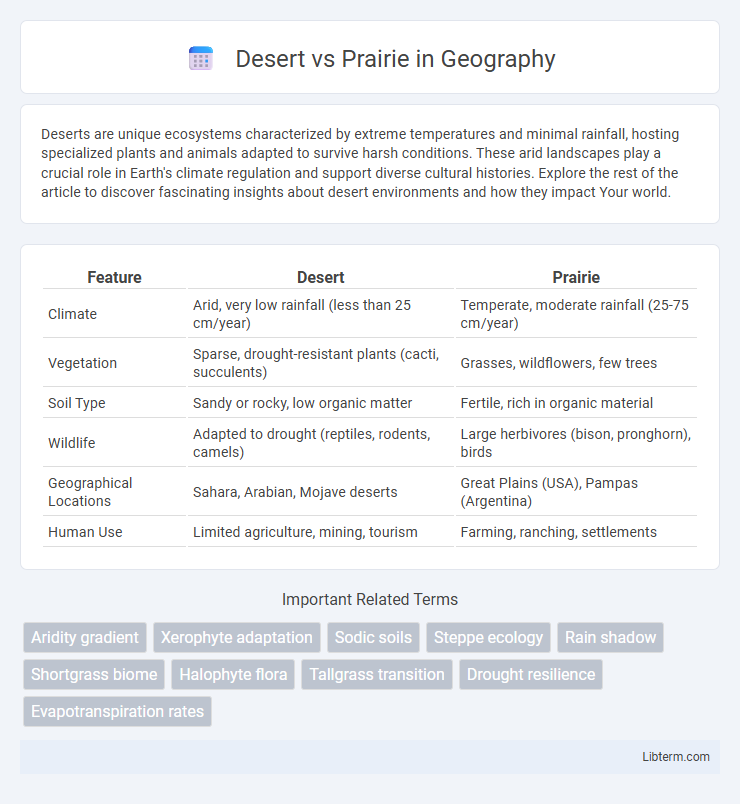Deserts are unique ecosystems characterized by extreme temperatures and minimal rainfall, hosting specialized plants and animals adapted to survive harsh conditions. These arid landscapes play a crucial role in Earth's climate regulation and support diverse cultural histories. Explore the rest of the article to discover fascinating insights about desert environments and how they impact Your world.
Table of Comparison
| Feature | Desert | Prairie |
|---|---|---|
| Climate | Arid, very low rainfall (less than 25 cm/year) | Temperate, moderate rainfall (25-75 cm/year) |
| Vegetation | Sparse, drought-resistant plants (cacti, succulents) | Grasses, wildflowers, few trees |
| Soil Type | Sandy or rocky, low organic matter | Fertile, rich in organic material |
| Wildlife | Adapted to drought (reptiles, rodents, camels) | Large herbivores (bison, pronghorn), birds |
| Geographical Locations | Sahara, Arabian, Mojave deserts | Great Plains (USA), Pampas (Argentina) |
| Human Use | Limited agriculture, mining, tourism | Farming, ranching, settlements |
Introduction to Deserts and Prairies
Deserts are arid ecosystems characterized by low precipitation, extreme temperature fluctuations, and sparse vegetation adapted to drought conditions. Prairies are temperate grasslands featuring moderate rainfall, rich soils, and diverse grasses that support a variety of herbivores and ground-nesting birds. The distinct climatic and soil conditions between deserts and prairies shape their unique plant and animal communities worldwide.
Geographic Distribution and Climate
Deserts are primarily found in regions such as the Sahara in Africa, the Arabian Peninsula, and parts of the southwestern United States, characterized by extremely low precipitation typically below 250 mm annually and high temperature fluctuations. Prairies are located mainly in the central United States and Canada, with moderate rainfall between 500 to 900 mm per year, supporting grassland ecosystems with hot summers and cold winters. The distinct climatic conditions, with deserts having arid, dry environments and prairies experiencing more temperate, moist climates, directly influence their respective geographic distributions and vegetation types.
Soil Composition and Fertility
Desert soils are typically characterized by low organic matter, high mineral content, and poor fertility due to limited moisture and sparse vegetation, resulting in slow nutrient cycling. Prairie soils, especially mollisols, boast rich organic matter, high humus content, and excellent fertility driven by dense grass root systems and seasonal decomposition. The contrasting soil composition directly influences plant growth, with prairies supporting robust ecosystems while deserts sustain more specialized, drought-tolerant flora.
Typical Flora: Desert vs Prairie Plants
Desert plants such as cacti, succulents, and creosote bushes have adapted to arid conditions by developing water retention mechanisms and reduced leaf surfaces. Prairie plants predominantly include tall and short grasses like big bluestem, switchgrass, and needlegrass, which thrive in nutrient-rich soils and periodic fires. The distinct flora of deserts and prairies reflects their unique climate adaptations, soil types, and moisture availability.
Diverse Fauna: Animals of Each Ecosystem
Deserts host a variety of specialized fauna such as camels, scorpions, and nocturnal rodents adapted to extreme temperatures and scarce water. Prairies support large herbivores like bison, prairie dogs, and diverse bird species including meadowlarks and hawks, thriving in grassland environments with rich vegetation. These animals reflect distinct evolutionary strategies shaped by the harsh aridity of deserts and the fertile, temperate conditions of prairies.
Adaptations to Extreme Environments
Deserts and prairies exhibit unique adaptations to extreme environmental conditions, with desert organisms evolving water conservation mechanisms such as succulent tissues, nocturnal activity patterns, and deep root systems to survive arid, high-temperature climates. Prairie species adapt by developing extensive root networks for drought resistance, seasonal growth cycles aligned with precipitation patterns, and fire-resistant traits to endure periodic wildfires and nutrient-poor soils. These specialized adaptations enable both ecosystems to maintain ecological balance despite challenging abiotic stresses.
Human Impact on Deserts and Prairies
Human activities have significantly altered deserts and prairies, with urbanization, agriculture, and resource extraction causing habitat loss and soil degradation. Desert ecosystems face challenges from groundwater depletion and off-road vehicle use, which disrupt native vegetation and accelerate erosion. Prairie landscapes experience extensive conversion to croplands and overgrazing, leading to reduced biodiversity and compromised soil health.
Conservation Challenges and Efforts
Desert ecosystems face conservation challenges such as water scarcity, habitat fragmentation, and invasive species threatening endemic flora and fauna. Prairie conservation efforts focus on restoring native grasses, managing fire regimes, and controlling agricultural expansion to preserve biodiversity. Both biomes require targeted strategies to maintain ecological balance and mitigate the impacts of climate change and human activities.
Role in the Global Ecosystem
Deserts play a crucial role in the global ecosystem by regulating temperature extremes and serving as carbon sinks through specialized vegetation adapted to arid conditions. Prairies support biodiversity hotspots and contribute significantly to soil health and carbon sequestration through their extensive root systems and grassland biomass. Both biomes influence global climate patterns by affecting water cycles and atmospheric carbon levels, making their conservation vital for ecological balance.
Key Differences and Similarities
Deserts and prairies differ primarily in climate and vegetation; deserts receive less than 10 inches of annual rainfall with sparse, drought-resistant plants, while prairies have moderate rainfall (20-35 inches) supporting dense grasses and occasional trees. Both biomes experience extreme temperature variations and host specialized wildlife adapted to their unique environments. Soil composition contrasts with sandy, nutrient-poor soils in deserts versus rich, fertile soils in prairies, crucial for agriculture.
Desert Infographic

 libterm.com
libterm.com